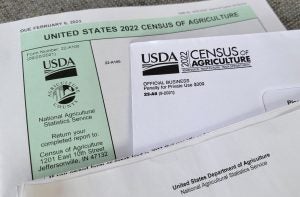If you’re anything like me, you’ve been bombarded in recent months by U.S. Department of Agriculture mailings urging you to fill out the 2022 Census of Agriculture. In fact, you may also be continuing to receive these correspondences even after you’ve filled out your paperwork and submitted it (yes, that’s perplexing, but the USDA has said that we can disregard these followup letters). But with the deadline for the newest Census of Agriculture coming up on Monday, February 6, it’s no surprise that the USDA’s National Agricultural Statistics Service is eager to make one final push to get agricultural producers to turn in their documentation.
Conducted just once every five years, the Census of Agriculture aims to provide a complete account of the nation’s farms and ranches and the people who operate them. Technically speaking, responding to the Census of Agriculture is required by federal law under Title 7 USC 2204(g) Public Law 105-113, which is the same law that requires the NASS to keep all individual operations’ information confidential, use the data for statistical purposes only, and publish the data in aggregate form to prevent disclosing the identity of any individual producer or farm operation.
According to the NASS, the data received in the census highlights changes, trends, and challenges across nearly every aspect of agriculture. It is a key factor in determining farm policy and, hopefully, it helps strengthen rural America’s voice. The census remains the only source of uniform, comprehensive, and impartial agriculture data for every state, county, and U.S. territory.

While I had hoped to ask some questions about the census to a USDA official in person, our schedules weren’t aligning well. But, I was able to connect over email with Lance Honig, Chief of Crops Branch at the USDA’s NASS, about the census. Here’s his reply to some of my questions:
AGDAILY: What value does the census provide when informing policy and resource distribution? Could you provide some examples you have seen?
Honig: Ag census data influence policy and resource distribution and are used by other USDA agencies, ag producers, community planners, legislators and researchers to inform programs.
For example, federal, state, and local policymakers can use NASS data to inform programs and budgets that benefit agriculture constituents. This has resulted in a governor’s commission to support the poultry industry, counties developing right-to-farm legislation and a snow removal budget that ensures clear roads for daily product transportation in one state.
AGDAILY: How does USDA overcome farmer hesitation to respond to the census and how do they protect respondents’ information? Why is this aspect important?
Honig: As the statistical agency for USDA, we are committed to keeping respondents’ information secure and confidential, during and after collection.
During preparation, official estimates and forecasts are prepared under tight security to ensure that only authorized staff working on reports have access to the information before it’s released. All NASS employees have signed a written pledge and are subject to a jail term, fine, or both if they disclose confidential information.
After collection, NASS only publishes aggregated data and never publishes survey results in a way that identifies individuals or their operations unless the individual has approved the release of the data in writing.
Additionally, information provided for NASS surveys is protected by law under Title 7 and the Confidential Information Protection and Statistical Efficiency Act (CIPSEA) which requires that names, addresses, latitude/longitude coordinates, reported data, and other personal information is not disclosed.
AGDAILY: What kind of turnout has there been so far regarding responses and is the number of responses on par with the collection from the 2017 census?
Honig: Online response has increased compared to previous censuses, and overall response shows we can expect more in the next week as we near the due date, Feb. 6.
AGDAILY: Historically, has the party in power in the White House had an impact on what percentage of producers fill out the census?
Honig: Many factors affect response, but we don’t currently measure the impact of any one of them. We cannot make a direct correlation between the party in power and ag census return rates through the years.
AGDAILY: Are there any new data points that the USDA is trying to highlight for 2022 that would be interesting or relevant to the current landscape?
Honig: New questions in this year’s census include the use of precision agriculture, hemp production, hair sheep, and updates to internet access questions.
These new topics reflect changes and trends in U.S. agriculture and allow us to continue to provide relevant agricultural data to decision-makers in addition to helping inform policies and programs to support our nation’s farmers.
AGDAILY: How can people respond to the census now? Do farmers seem to have a preference in the method they use to respond (paper versus online)?
Honig: The census is currently available online with a provided survey code on their questionnaire, and responses are required by February 6, 2023. Producers can also fill out the census questionnaire via mail, which was provided in December, or telephone at 1-888-424-7828. Return data shows online response has increased compared to previous censuses.
The Census of Agriculture focuses on U.S. farm operations of all sizes, urban and rural, which produced and sold, or normally would have sold, $1,000 or more of agricultural products in 2022. Also included are Puerto Rico farm operations that produced and sold, or normally would have sold, $500 or more of agricultural products in the ag census year.
Whether producers responded online or by mail, they can verify their reports were received by going to agcounts.usda.gov, entering their survey codes, and checking the submitted date under the status column of the My Surveys tab. The status update is not always immediate. The update can take a few minutes up to several days, especially if the questionnaire was returned by mail.



